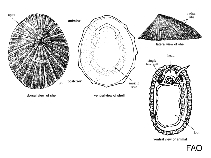Lottia digitalis (Rathke, 1833)
Ribbed limpet| Native range | All suitable habitat | Point map | Year 2050 |

|
| This map was computer-generated and has not yet been reviewed. |
| Lottia digitalis AquaMaps Data sources: GBIF OBIS |
Upload your photos
Google image | No image available for this species;
drawing shows typical species in Lottiidae.
Google image | No image available for this species;
drawing shows typical species in Lottiidae.
Classification / Names Common names | Synonyms | CoL | ITIS | WoRMS
Gastropoda | Not assigned | Lottiidae
Environment: milieu / climate zone / depth range / distribution range Ecology
Benthic. Subtropical
Distribution Countries | FAO areas | Ecosystems | Occurrences | Introductions
Pacific Ocean: Alaska to Mexico. Climate: boreal to tropical.
Length at first maturity / Size / Weight / Age
Maturity: Lm ? range ? - ? cm Max length : 3.5 cm SHL male/unsexed; (Ref. 312); common length : 3.0 cm SHL male/unsexed; (Ref. 312)
Short description Morphology
The peak near the front edge is far forward and may occasionally overhang the edge. The exterior varies in color but is usually brownish or olive green with a mix of large and fine dots. It is often pitted by a parasitic fungus and may have an eroded top (Ref. 312); Has a shell with an apex that is anterior. The anterior slope of the shell is concave and the posterior portion of the shell is convex. It has a strong ribbing on the posterior region. The shells are colored brownish green to greenish black and frequently appear eroded with white spots. The side of the foot is white (Ref. 310).
It has a shell length of 1.5 to 3.5 cm (Ref. 312). Habitat: Occurs in the high intertidal zone, on vertical and underside of rocks at low tide (Ref. 312); common in the high rocky intertidal zone and are typically found on vertical and overhanging rock faces and infrequently in tide pools; occasionally it is also found living on the goose-neck barnacle Pollicipes polymerus (Refs. 310, 95344). Inhabits deep cracks and crevices (Ref. 95344). Diet: microscopic films of algae; encrusting diatoms (Ref. 312). Behavior: Feeds at high tide when submerged. When exposed it becomes less active and attaches itself to the rock below usually with the anterior portion of their shell pointed down. It has the ability to secrete a mucus between its foot and shell that serves to secure on to the rock below and prevent desiccation and dislodgement. When exposed the heart and respiration rate also decreases. Respiration occurs through both a vascularized mantle fold and a single gill; in aggregate groups of 44 individuals. Predator: shorebirds and the crab Pachygraspsus crassipes (Ref. 312).
Life cycle and mating behavior Maturity | Reproduction | Spawning | Eggs | Fecundity | Larvae
Reproduction: Spawning occurs in the winter, spring and summer. Has a short veliger stage. Typically the planktonic (veliger) larvae only remain in the water column for a few days to around a month. Recruitment of new individuals occurs typically from November to January. This short planktonic stage only allows for a limited dispersal of new individuals and recruitment is typically from the same or adjacent shore (Ref. 310).
Main reference
References | Coordinator | Collaborators
Gallivan, G. and J. Danforth. 1999. (Ref. 312)
IUCN Red List Status (Ref. 130435)
CITES status (Ref. 108899)
Not Evaluated
CMS (Ref. 116361)
Not Evaluated
Threat to humans
Human uses
| FishSource |
Tools
More information
Internet sources
BHL | BOLD Systems | CISTI | DiscoverLife | FAO(Publication : search) | Fishipedia | GenBank (genome, nucleotide) | GloBI | Gomexsi | Google Books | Google Scholar | Google | PubMed | Tree of Life | Wikipedia (Go, Search) | Zoological Record
Estimates based on models
Preferred temperature
(Ref. 115969): 6.4 - 14.2, mean 9.1 (based on 384 cells).
Price category
(Ref. 80766):
Unknown.



